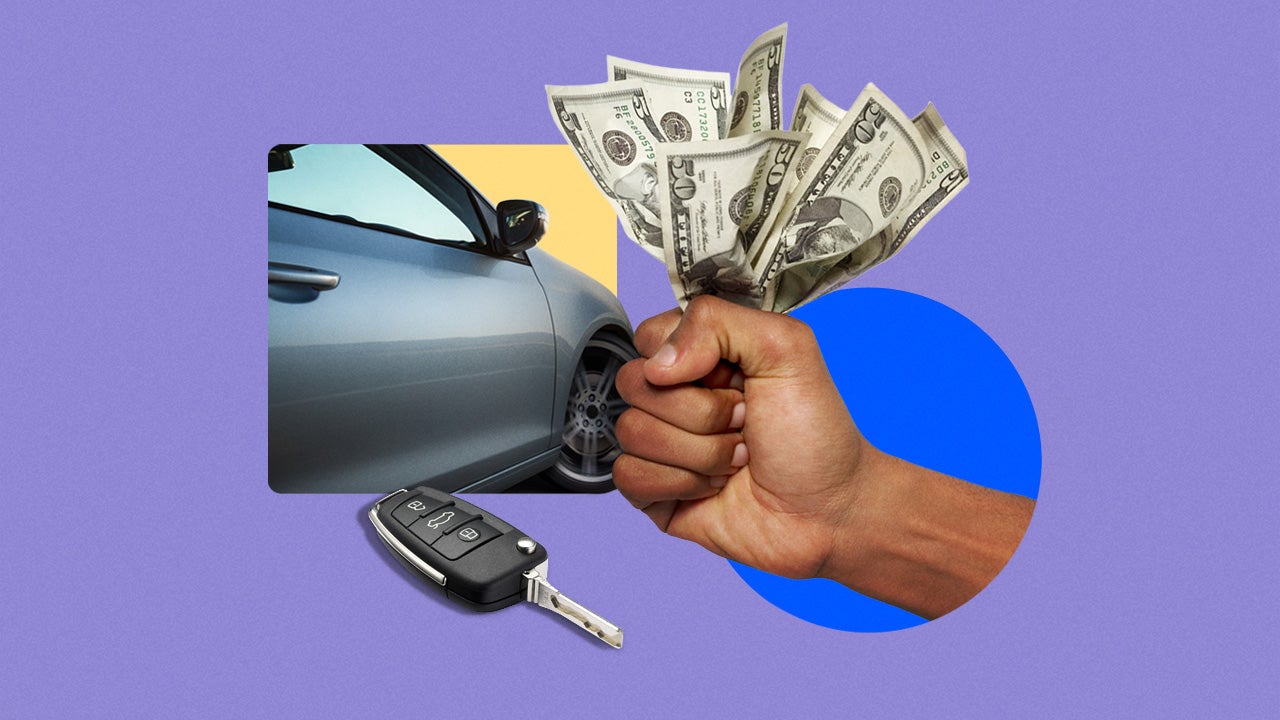Images by Getty Images; Illustration by Issiah Davis/Bankrate
Key takeaways
- Cash-out auto refinancing lets you borrow money by swapping your car loan out for a larger loan, typically with different terms.
- The amount you can access depends on your vehicle’s value, your credit history and the lender.
- Be sure to consider the risk of going upside down on your loan, which could make it challenging to sell or trade your vehicle in the near future.
- Weigh the benefits and drawbacks of this strategy to get fast cash to determine if it makes financial sense for you.
Cash-out auto loan refinancing, also known as cash-back refinancing, is like traditional refinancing in the sense that you apply to receive new, more favorable terms to replace your current loan. However, you’re refinancing for a larger amount than you owe, meaning you will receive a lump sum of cash. The amount you receive depends on the equity present in your vehicle.
Car owners may consider this type of refinance if they urgently need money, but this choice comes with the cost of increasing the borrower’s debt.
What is cash-out auto refinancing?
A cash-out auto refinance loan allows you to swap out your current loan for a new one for a higher amount and access the difference in cash. The variance between the two loans is the amount of equity you have in your vehicle or the amount you own outright. This type of loan is typically used by people still paying off their car who have equity in their vehicle and need extra money.
Not all lenders offer this service, and it can be a risky move. Cash-out refinancing increases the possibility of becoming upside-down on your loan, making your car more challenging to sell until you’re no longer upside-down.
Being upside down means your outstanding loan balance is more than the vehicle is worth. In other words, if you owe $4,000 on a car loan, but the car’s value is only $2,000, you are upside-down on the loan. If you have no plans to sell the car, being upside down is not necessarily a problem. Just continue to make payments and pay off the loan.
If, on the other hand, you hope to trade in your vehicle, being upside-down can be a challenge. You’ll need to pay off the negative equity yourself.
How much can I borrow through a cash-out loan?
The amount you can borrow through cash-out refinancing is dependent on a few factors. There’s no single answer — instead, it will depend on your lender, the equity in your vehicle and your finances.
When is cash-out auto refinancing a good idea?
Cash-out auto refinancing is a good idea if you have experienced a financial emergency and need money or if you intend to use the cash to pay off debt with higher interest, like credit card debt.
Determining whether a cash-out auto refinance is right for you takes reflection on your spending habits. Because this choice means borrowing more money than you already owe, you are creating more debt. If you are currently struggling to make your monthly payments, this could worsen your financial situation.
The two primary benefits of cash-out refinancing are improved loan terms and additional cash.
- Improved loan terms: Just as with traditional refinancing, you will ideally receive more favorable interest rates through this process. But you’ll increase your loan principal, and if you want to lower your monthly payment, you’ll likely need to extend the loan term. That means you’ll spend more on interest over the loan’s lifetime.
- Additional cash: You will receive money from a cash-back refinance, which can be especially helpful if you need additional cash for an emergency. However, this is a short-term solution that could lead to higher interest rates.
Risks of cash-out refinancing
As with any auto loan product, cash-back auto refinance has risks. Consider these potential drawbacks before proceeding.
- Going upside down on a loan: You are more likely to become upside down or underwater on your loan. As the car’s value depreciates, your loan-to-value ratio increases the likelihood of being underwater, owing more than the vehicle is worth. Having negative equity is also a major risk if you get in an accident and your insurance does not cover the full cost.
- Incurring more debt: Borrowing more than you owe stacks even more debt on your plate.
- Risk of repossession: If you struggle to keep up with your monthly payments, extending your loan may not be enough to fix deeper financial problems. This could mean your vehicle is repossessed if you fail to pay.
- Limited lender choices: Not all lenders offer this type of financing, so you may be limited to a few options when shopping around.
Lenders that offer cash-out loans
| Lender | APR | Loan amount | Loan term |
|---|---|---|---|
| RefiJet | 4.99%-21.99% | $5,000–$150,000 | 24–96 |
| RateGenius | 4.85%-% | $8,000–$150,000 | 12–96 |
| iLending | 5.49%-19.24% | $5,000–$150,000 | 12–96 |
| Autopay | 4.85%-% | $8,000–$120,000 | 12–96 |
Bankrate’s view
RefiJet offers cash-out auto refinancing that depends on several factors, like your equity, vehicle age, your credit score and the repayment term of your loan. It boasts a simple and straightforward process.
Pros
- Claims to make the cash-out refinance process easy.
- Offers extended service contracts that can be included in your loan.
Cons
- Your vehicle must be 10 years old or newer.
Bankrate’s view
RateGenius won Bankrate’s best for auto refinancing award in 2025, and it also offers a cash-out refinancing option if you’re able to qualify.
Pros
- It does not require perfect credit.
- Allows co-applicants.
Cons
- Limited information about cash-out refinances on its website.
Bankrate’s view
Although iLending doesn’t discuss the details of its cash-out refinances on its website, it does offer this type of financing. If you’re interested, you can call its toll-free number to discuss your options.
Pros
- You’ll be matched with a personal lending specialist.
- It does not require perfect credit.
Cons
- Loan fees are not disclosed up front.
- No physical locations means no in-person service.
Bankrate’s view
Autopay has a page on its website dedicated to auto loan cash-out refinances. Its guide doesn’t provide much specific information about its options, but it does include what the process generally entails.
Pros
- A maximum loan term of 96 months is longer than most competitors.
- It does not require perfect credit.
Cons
- Fees are included in the APR quoted, but not disclosed.
- The competitive rates are for the best credit borrowers, but other rates are not disclosed for poor credit.
How to apply for cash-out auto refinancing
The process of applying for a cash-out auto refinance is similar to what you would do for a traditional refinance. Here are the typical steps for applying for a cash-out auto refinance.
- Research your vehicle’s value. To get an idea of how much your car is worth, estimate your car’s value using websites like Kelley Blue Book and Edmunds.
- Calculate your vehicle’s equity. Next, calculate how much equity you have in the car by subtracting your current loan from your vehicle’s current value. If you want to avoid mental math, an equity calculator can handle the calculations for you.
- Find a lender. Research lenders that offer cash-back auto refinancing. Afterward, compare the terms, such as rates and the cash back offer, to determine which option is best for you.
- Submit application. After choosing a lender, submit a formal loan application. Once approved, you will walk away with new loan terms and extra money.
Bottom line
Cash-out refinancing can be a good option if you’re looking to score more favorable terms on your auto loan or have an urgent need for cash. The first step when considering this type of refinance is to research the current value of your car and how much you owe. This will help determine how much money a lender may be willing to give you.
But remember, there are risks involved in a cash-out refinance. You incur more debt by refinancing the auto loan for more than what’s currently owed, and you also risk becoming upside-down on the loan.
Why we ask for feedback
Your feedback helps us improve our content and services. It takes less than a minute to
complete.
Your responses are anonymous and will only be used for improving our website.
Help us improve our content
Read the full article here
















